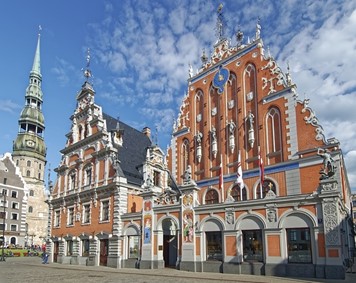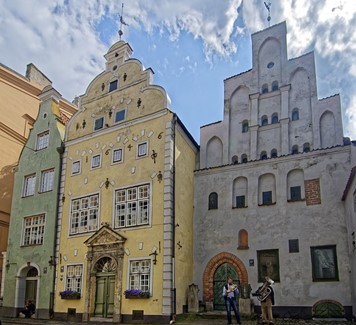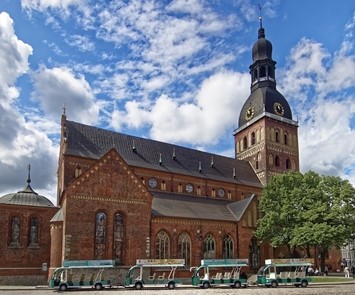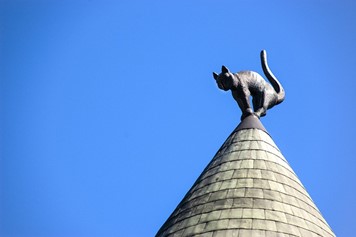Sightseeing in Riga's Old Town
At the heart of Latvia's capital you'll find the oldest part of the city, Old Town locally known as Vecrīga. The historic city centre was named a UNESCO World Heritage site in 1997 and is home to many of the city's sights.
Town Hall Square
Once the beating heart of the city, today the square is home to the city council, the main tourist office and the House of the Blackheads. The House of the Blackheads is perhaps Riga's most renowned building. First build in 1334, the building's name comes from the Brotherhood of the Blackheads. The Brotherhood was a guilt of banquet caterers who chose St Maurice as their patron saint, who was traditionally depicted as a black soldier in knight's armour.
Though the building was destroyed by bombs in the Second World War, it was fully rebuilt in 1995. Today it is a venue for exhibitions, concerts and other events. Inside you can visit the medieval cellars, Celebration Hall with its royal paintings on the wall and ceiling painting "Apotheosis of Saint Maurice" and several other rooms which have all been painstakingly restored to their original state.
St. Peter's Church
Within the relatively confined area of Old Town you can find several houses of worship belonging to different religious denominations. The Lutheran church of St. Peter is one of the oldest buildings in the city, though little, if any, of the original structure can still be seen today. The oldest known document to mention the church dates back to 1209 when it was a small hall-type three aisle building with an aloof standing church tower.
What can be seen of the church today mostly dates back to the 15th and 17th centuries. The 123-metre steeple is easy to spot on any skyline view and you can climb up to a viewing platform at 72 metres with a 360-degree view of the city. The inside of the church provides fascinating insights into Riga's history and often features temporary exhibitions of work by local artists.
The Three Brothers
Riga's Old Town consists of many different architectural styles, fittingly it is also home to the Latvian Museum of Architecture. The museum can be found in three former dwellings on Maza Pils street, each dwelling was build during a different period and thus illustrates a different architectural style.
Old Town has many narrow cobble-stone streets which lead from medieval towers to Baroque church spires and back again to a Neo-Classical Medieval castle. Though Art Nouveau buildings make up roughly a third of all buildings in the city, you won't many of them in Old Town.
Riga Castle
For centuries this has been the seat of power in Latvia. This continues to be true today as part of the castle is used as the official residence of the President of Latvia. The current building is actually the third iteration of the Castle, build upon the foundations of the former castle at the beginning of the 16th century.
As the castle has been reconstructed many times it lost some and gained other artistic and architectural features through the years. Today the castle has six towers, walls that are three metres thick and underground passages that lead in various directions from the castle.
As part of the castle is used by the President, not all of the castle can be visited. In the past century the castle was also home to the National History Museum, however after a fire in 2013 the museum has been temporarily relocated until renovations are finished.
Riga Cathedral
The first foundation stone laid for the Riga Cathedral was placed by Bishop Albert in the summer of 1211, making it one of the oldest buildings not only in Latvia but also in the Baltic States. Riga Cathedral is the seat of the Archbishop of the Latvian Evangelical Lutheran Church. Due to renovations over the centuries, the cathedral now combines features from Romanesque, Early Gothic, Baroque and Art Nouveau styles.
On the site of the cathedral you can also visit the Museum of the History of Riga and Navigation and the cathedral's Cloister, which was also build in the 13th century. The Cloister houses several collections of the museum including cannons and their equipment, a plaster replica of a statue of Russian Czar Peter I and coats of arms of families, societies and fraternities formerly displayed in niches of the cathedral.
For centuries, Riga Cathedral has been home not only to church services but also many musical events. This tradition continues today with music of various ages played during church services and at regular concerts.
And so much more...
Though Old Town only covers about 1 square kilometre there is still plenty more to see and do there. Other houses of worship you might want to visit include St. Jacob Catholic Cathedral and the Peitav-Shul synagogue, the only synagogue in Riga to survive the Holocaust.
Other historical sights include the Powder Tower, a 14th century fortification tower which houses the Latvian War museum, and the Swedish Gate, a 17th century gate which was part of the city walls. For those looking for something a bit more quirky visitors can visit a 20th century medieval inspired building known as the Cat House, which has two cat sculptures on roof turrets.
